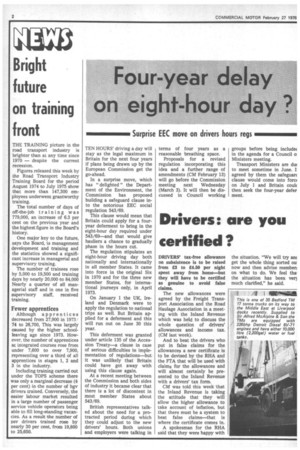Bright future on training front
Page 4

If you've noticed an error in this article please click here to report it so we can fix it.
THE TRAINING picture in the road transport industry is brighter than at any time since 1970 — despite the current recession.
Figures released this week by the Road Transport Industry Training Board for the period August 1974 to July 1975 show that more than 147,300 employees underwent grantworthy training.
The total number of days of off4he-job training was 779,000, an increase of 6.3 per cent on the previous year and the highest figure in the Board's history.
One major key to the future, says the Board, is management development and training and the statistics showed a significant increase in managerial and supervisory training.
The number of trainees rose by 5,000 to 19,500 and training days by nearly 20,000 to 84,000 Nearly a quarter of all managerial staff and in one in five supervisory staff, received training.
Fewer apprentices
Although apprentices decreased from 27,900 in 1973 ' 74 to 26,700, This was largely caused by the higher schoolleaving age since 1973. However, the number of apprentices at integrated courses rose from under 7,600 to over 7,900, representing over a third of all apprentices in stages 1, 2 and 3 in the industry.
Including training carried out under the TOPS scheme there was only a marginal decrease (4 per cent) in the number of hgv drivers trained. Conversely, the easier labour market resulted in a large number of passenger service vehicle operators being able to fill long-standing vacancies. As a result the number of psv drivers trained rose by nearly 30 per cent, from 19,800 to 25,650.




















































































